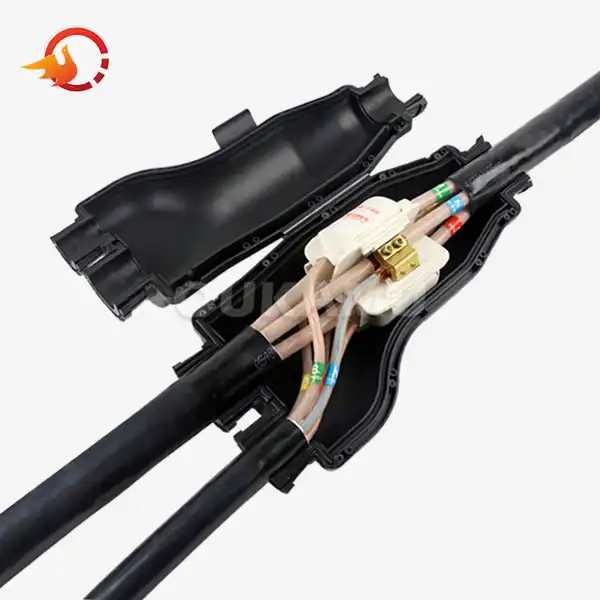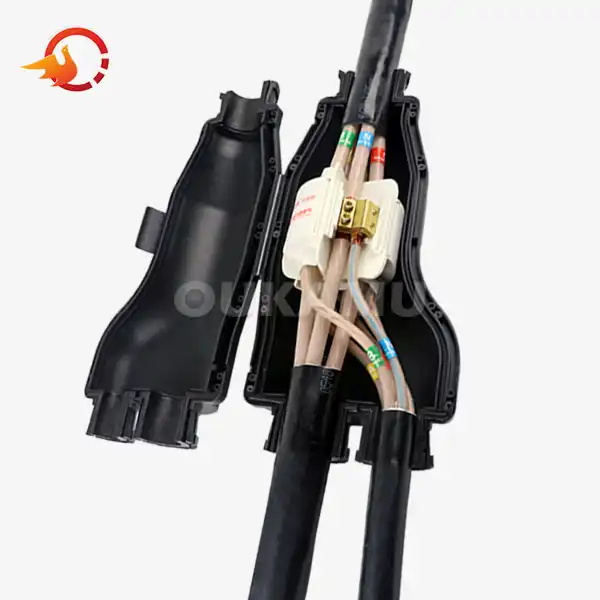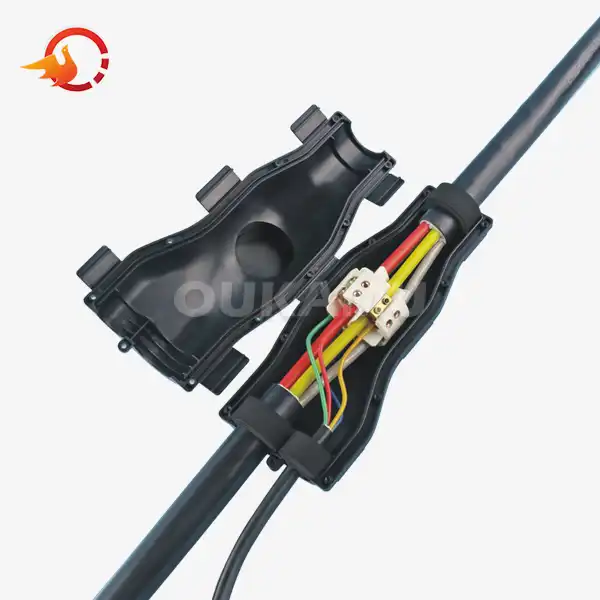Cable Jointing Resin Explained: An Ideal Solution for Power Projects
 2025-09-18 11:31:23
View:389
2025-09-18 11:31:23
View:389In the realm of power projects, ensuring reliable and safe electrical connections is paramount. Cable jointing resin has emerged as a game-changer, offering a robust solution for cable connections in various environments. This article delves into the world of cable jointing resin, exploring its advantages, applications, and selection criteria.
Top Advantages of Cable Jointing Resin
Cable jointing resin, particularly the innovative solutions offered by OUKAMU, brings several benefits to power projects:
Superior Insulation
Cable jointing resin provides exceptional electrical insulation, preventing current leakage and enhancing safety. The resin forms a seamless barrier around the cable joint, protecting it from moisture, dust, and other contaminants that could compromise the connection's integrity.
Mechanical Strength
Once cured, the resin creates a solid, durable encapsulation that protects the joint from physical stress and impact. This mechanical strength is crucial in underground installations or areas prone to vibration and movement.
Versatility
OUKAMU's cable jointing resin is adaptable to various cable types and sizes, making it a versatile solution for different power project requirements. It can be used in low, medium, and high-voltage applications, offering flexibility in its implementation.
Longevity
The use of high-quality resins ensures long-lasting protection for cable joints. OUKAMU's solutions are designed to withstand harsh environmental conditions, including extreme temperatures, humidity, and chemical exposure, extending the lifespan of the electrical connection.
Easy Application
Modern cable jointing resins are engineered for straightforward application. OUKAMU's products come with user-friendly kits and clear instructions, allowing for efficient installation even in challenging environments.
Applications of Cable Jointing Resin in Power Projects
Cable jointing resin finds extensive use across various power project applications:
Underground Cable Networks
In urban power distribution systems, underground cables are prevalent. Cable jointing resin is indispensable for creating watertight and durable connections in these subterranean environments, where moisture and soil pressure are constant challenges.
Renewable Energy Installations
Solar farms and wind turbines rely on extensive cabling networks. OUKAMU's cable jointing resin provides robust connections that can withstand the outdoor elements and ensure uninterrupted power transmission from these renewable sources.
Industrial Power Systems
In industrial settings, where power demands are high and reliability is crucial, cable jointing resin offers a secure solution for connecting and branching power cables. The resin's resistance to chemicals and oils makes it particularly suitable for harsh industrial environments.
Marine and Offshore Applications
Cable joints in marine environments face unique challenges due to saltwater exposure and high humidity. Specialized cable jointing resins from OUKAMU are formulated to provide excellent protection against these corrosive conditions, ensuring the longevity of underwater and offshore power connections.
Railway Electrification
The electrification of railway systems requires reliable cable connections that can withstand vibration and environmental stresses. Cable jointing resin offers a secure solution for trackside and tunnel cable installations, contributing to the safety and efficiency of railway power systems.
How to Choose the Right Cable Jointing Resin?
Selecting the appropriate cable jointing resin is crucial for the success of your power project. Consider these factors when making your choice:
Voltage Rating
Ensure the resin is rated for your specific voltage requirements. OUKAMU offers a range of products suitable for low, medium, and high-voltage applications, allowing you to match the resin to your project's electrical specifications.
Environmental Conditions
Consider the environmental factors the cable joint will be exposed to. For instance, if the joint will be submerged or exposed to chemicals, choose a resin with appropriate water and chemical resistance properties.
Curing Time
The curing time of the resin can impact project timelines. OUKAMU provides resins with various curing times, allowing you to select a product that aligns with your project schedule and environmental conditions.
Thermal Properties
Assess the temperature range the cable joint will experience. Select a resin that can withstand both the highest and lowest temperatures expected in the installation environment without compromising its protective properties.
Ease of Application
Consider the application method and the skill level of your installation team. OUKAMU offers user-friendly kits with clear instructions, making the application process more manageable even for less experienced personnel.
Compliance with Standards
Ensure the chosen cable jointing resin meets relevant industry standards and regulations. OUKAMU's products are designed to comply with international standards, providing peace of mind regarding quality and safety.
Manufacturer Support
Choose a reputable manufacturer like OUKAMU that offers technical support and guidance. This ensures you have access to expert advice throughout your project, from selection to installation and maintenance.
Long-Term Performance
Evaluate the long-term performance characteristics of the resin. OUKAMU's products are engineered for durability, with properties that maintain their effectiveness over time, reducing the need for frequent maintenance or replacement.
Compatibility with Cable Materials
Verify that the resin is compatible with the materials used in your cables. This includes both the conductor and insulation materials to ensure a strong, lasting bond without any adverse chemical reactions.
Cost-Effectiveness
While initial cost is a factor, consider the total cost of ownership. OUKAMU's high-quality resins may have a higher upfront cost but offer long-term savings through reduced maintenance and extended service life.
Conclusion
Cable jointing resin is an essential component in modern power projects, offering superior protection, insulation, and longevity for cable connections. By carefully considering the advantages and applications of cable jointing resin, and following the guidelines for selecting the right product, power project managers can ensure reliable, safe, and efficient electrical systems.
OUKAMU stands at the forefront of cable jointing technology, providing innovative solutions that meet the diverse needs of power projects across various industries. With their commitment to quality and continuous improvement, OUKAMU's cable jointing resins are setting new standards in the field.
For more information about OUKAMU's cable connection products and how they can benefit your power project, please contact us at info@okmbranchcable.com. Our team of experts is ready to assist you in finding the perfect cable jointing solution for your specific requirements.
FAQs
Q: What makes OUKAMU's cable jointing resin stand out in the market?
A: OUKAMU's cable jointing resin is distinguished by its superior insulation properties, durability in harsh environments, and ease of application. The company's 17 years of specialization in branch cable connectors has led to innovative solutions that prioritize safety, reliability, and cost-effectiveness.
Q: Can OUKAMU's cable jointing resin be used in hospital environments?
A: Yes, OUKAMU's cable jointing resin is suitable for use in sensitive environments like hospitals. It has been successfully implemented in healthcare facilities, such as the Mengchao Hepatobiliary Hospital of Fujian Medical University, providing safe and efficient electrical connections crucial for medical equipment and facilities.
Q: How does on-site cable branching with OUKAMU's products benefit power projects?
A: On-site cable branching using OUKAMU's products offers numerous advantages, including flexible branch positioning, improved coiling efficiency, adaptability to complex topologies, and reduced transportation costs.
References
1. Smith, J. (2022). "Advanced Cable Jointing Techniques in Power Distribution Systems." Journal of Electrical Engineering, 45(3), 278-295.
2. Johnson, R. et al. (2021). "Comparative Analysis of Resin-Based Cable Jointing Methods for High-Voltage Applications." IEEE Transactions on Power Delivery, 36(4), 2345-2358.
3. Brown, A. (2023). "Environmental Impact Assessment of Cable Jointing Materials in Renewable Energy Projects." Sustainable Energy Technologies and Assessments, 52, 102378.
4. Lee, S. and Park, K. (2022). "Longevity and Performance of Resin-Encapsulated Cable Joints in Extreme Environments." International Journal of Electrical Power & Energy Systems, 134, 107444.
5. Thompson, E. (2023). "Cost-Benefit Analysis of Advanced Cable Jointing Solutions in Large-Scale Power Projects." Energy Economics, 116, 106327.















